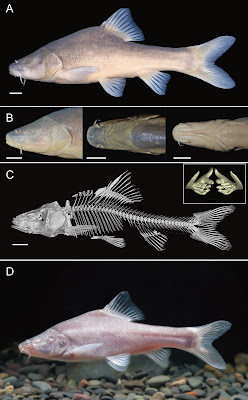 |
Hyleoglomeris dracosphaera Likhitrakarn, Sutcharit & Panha,
in Likhitrakarn, Jeratthitikul, Sapparojpattana, Siriwut, Srisonchai, Jirapatrasilp, Seesamut, Poolprasert, Panha et Sutcharit, 2024. |
Abstract
Thai species of the pill millipede genus Hyleoglomeris Verhoeff, 1910 are reviewed, and an annotated catalogue is provided. Six new species from Thailand are described and illustrated based on morphological characteristics and molecular analyses: H. dracosphaera sp. n., H. nigromaculata sp. n., H. suwannakhuhensis sp. n., H. bomba sp. n., H. tongkerdae sp. n., and H. krasoon sp. n. They are morphologically similar, yet all can be separated based on their characteristic colour patterns, telopod structures and geographic distributions. Genetic differences in the dna barcode region confirm their full species statuses, with interspecific coi p-distances ranging from 9.01% to 16.51% dissimilarity. We also propose the following new synonym: H. hongkhraiensis Likhitrakarn, Golovatch & Panha, 2015 = H. cavicola Likhitrakarn, Golovatch & Panha, 2015 syn. n. This is based on the low genetic divergence observed between these two taxa (2.34% coi p-distance). A new distribution map of and a key to all Hyleoglomeris species presently known to occur in Thailand are also provided.
Keywords: Hyleoglomeris; key; millipede; new species; taxonomy; Thailand



Hyleoglomeris dracosphaera Likhitrakarn, Sutcharit & Panha, sp. n.
Name. To emphasize the orange body which, when rolled up into a sphere, resembles Dragon Balls, the magical artifacts in the Japanese manga and anime series Dragon Ball; adjective in feminine gender.
Hyleoglomeris nigromaculata Likhitrakarn, Sutcharit & Panha, sp. n.
Name. To emphasize the dark spots on the dorsum, adjective in feminine gender.
Hyleoglomeris suwannakhuhensis Likhitrakarn, Sutcharit & Panha, sp. n.
Name. To emphasize the type locality [Nong Bua Lamphu Province, Suwannakhuha District], adjective in feminine gender.
Hyleoglomeris bomba Likhitrakarn, Sutcharit & Panha, sp. n.
Name. To emphasize the body coloration with contrasting black and yellow bands, resembling the typical color pattern of a bumblebee of the genus Bombus, a noun in feminine gender.
Hyleoglomeris tongkerdae Likhitrakarn, Sutcharit & Panha, sp. n.
Name. To honour Assistant Professor Dr. Piyoros Tongkerd, malacologist and lecturer at the Faculty of Science at Chulalongkorn University, who participated in collecting many millipede specimens, including the type series of this new species.
Hyleoglomeris krasoon Likhitrakarn, Sutcharit & Panha, sp. n.
Name. To emphasize the word “krasoon” from the compound word “kingkeu krasoon” which means “pill millipede” in Thai, a noun in apposition.
Natdanai Likhitrakarn, Ekgachai Jeratthitikul, Pichsinee Sapparojpattana, Warut Siriwut, Ruttapon Srisonchai, Parin Jirapatrasilp, Teerapong Seesamut, Pisit Poolprasert, Somsak Panha, and Chirasak Sutcharit. 2024. Six New Species of the Pill Millipede Genus
Hyleoglomeris Verhoeff, 1910 (Diplopoda, Glomerida, Glomeridae) in Thailand revealed by DNA-barcoding.
Contributions to Zoology. DOI:
10.1163/18759866-bja10062
กิ้งกือกระสุนส้มดราก้อนบอลล์ 𝐻𝑦𝑙𝑒𝑜𝑔𝑙𝑜𝑚𝑒𝑟𝑖𝑠 𝑑𝑟𝑎𝑐𝑜𝑠𝑝ℎ𝑎𝑒𝑟𝑎 Likhitrakarn, Sutcharit & Panha, 2024
(draco = dragon มังกร, sphaera = sphere ทรงกลม)
ค้นพบที่ถ้ำผาท่าพล อ.เนินมะปราง จ.พิษณุโลก
กิ้งกือกระสุนน้อยลายจุดดำ 𝐻𝑦𝑙𝑒𝑜𝑔𝑙𝑜𝑚𝑒𝑟𝑖𝑠 𝑛𝑖𝑔𝑟𝑜𝑚𝑎𝑐𝑢𝑙𝑎𝑡𝑎 Likhitrakarn, Sutcharit & Panha, 2024
ค้นพบที่นอกถ้ำเวฬุวัน อ.ด่านช้าง จ.สุพรรณบุรี
กิ้งกือกระสุนน้อยสุวรรณคูหา 𝐻𝑦𝑙𝑒𝑜𝑔𝑙𝑜𝑚𝑒𝑟𝑖𝑠 𝑠𝑢𝑤𝑎𝑛𝑛𝑎𝑘ℎ𝑢ℎ𝑒𝑛𝑠𝑖𝑠 Likhitrakarn, Sutcharit & Panha, 2024
ค้นพบที่นอกถ้ำในวัดถ้ำภูผาธรรมสถิต อ.สุวรรณคูหา จ.หนองบัวลำภู
กิ้งกือกระสุนน้อยลายผึ้ง 𝐻𝑦𝑙𝑒𝑜𝑔𝑙𝑜𝑚𝑒𝑟𝑖𝑠 𝑏𝑜𝑚𝑏𝑎 Likhitrakarn, Sutcharit & Panha, 2024
ค้นพบที่นอกถ้ำในวัดถ้ำพระผาคอก อ.เวียงชัย จ.เชียงราย
กิ้งกือกระสุนน้อยทองเกิด 𝐻𝑦𝑙𝑒𝑜𝑔𝑙𝑜𝑚𝑒𝑟𝑖𝑠 𝑡𝑜𝑛𝑔𝑘𝑒𝑟𝑑𝑎𝑒 Likhitrakarn, Sutcharit & Panha, 2024
ตั้งชื่อเป็นเกียรติแด่ ผศ.ดร.ปิโยรส ทองเกิด อาจารย์จากหน่วยปฏิบัติการซิสเทแมติกส์ของสัตว์ ภาควิชาชีววิทยา คณะวิทยาศาสตร์ จุฬาลงกรณ์มหาวิทยาลัย ค้นพบที่บ้านท่าลี่ อ.แม่เมาะ จ.ลำปาง
กิ้งกือกระสุนน้อยกระสุน 𝐻𝑦𝑙𝑒𝑜𝑔𝑙𝑜𝑚𝑒𝑟𝑖𝑠 𝑘𝑟𝑎𝑠𝑜𝑜𝑛 Likhitrakarn, Sutcharit & Panha, 2024
ตั้งชื่อตามคำไทย “กระสุน” ที่ใช้เรียกกิ้งกือกลุ่มนี้ ค้นพบที่วัดถ้ำน้ำผ่าผางาม อ.แม่พริก จ.ลำปาง

















































